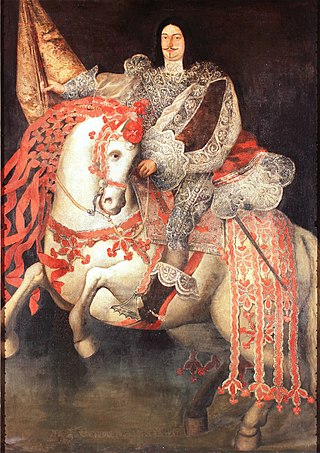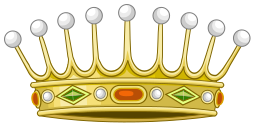
Francis Borgia was a Spanish Jesuit priest. The great-grandson of Pope Alexander VI, he was Duke of Gandía and a grandee of Spain. After the death of his wife, Borgia renounced his titles and became a priest in the Society of Jesus, later serving as its third superior general. He was canonized on 20 June 1670 by Pope Clement X.

Squillace is an ancient town and comune in the Province of Catanzaro, part of Calabria, Southern Italy.

Duke of Osuna is a Spanish noble title that was first awarded in 1562 by King Philip II of Spain to Pedro Girón de la Cueva,. Pedro was also Viceroy of Naples, (1582–1586), Ambassador in Portugal and 5th Count of Ureña.

Doña María Josefa Alonso-Pimentel y Téllez-Giróniure uxorisDuchess of Osuna, suo jure12th Duchess of Benavente, was a Spanish Salonnière, famous as a patron of artists, writers and scientists and an important figure of the Spanish Age of Enlightenment. She was the first female (honorary) member of the royal Sociedad Económica de Amigos del País de Madrid as well as the first president of the royal Junta de Damas de Honor y Mérito.

Francisco de Borja y Aragón, conde de Rebolledo, prince of Squillace was a Spanish writer, official in the court of King Philip III of Spain, and, from December 18, 1615 to December 31, 1621, viceroy of Peru.

Pedro Antonio Fernández de Castro, 10th Count of Lemos was a Spanish nobleman who was Viceroy of Peru from 1667 until his death.

Duke of Villahermosa is a hereditary title in the peerage of Spain, accompanied by the dignity of Grandee and granted in 1476 by John II to Alfonso de Aragón, a half-brother of Ferdinand II.

Duke of Gandía is a title of Spanish nobility that was first created in 1399 by Martin of Aragon and granted to Alfonso of Aragon and Foix. It has its origin in the lordship of Gandía created in 1323 by James II of Aragon. Later, having no direct descendants, the title passed from the House of Barcelona to the House of Trastámara.

Íñigo Lopez de Mendoza y Pimentel, 4th Duke of the Infantado was a Spanish nobleman. He was made a Knight of the Order of the Golden Fleece in 1546, the 193rd to receive that distinction. Duke of the Infantado is a title first granted in 1475 and was inherited upon his father's death in 1531. He was also 5th Count of Saldaña, 4th Marquess of Argüeso, 4th Marquess of Campóo, 5th Marquess of Santillana, 5th Count of Real de Manzanares, Señor de Mendoza, Señor de Hita, and Señor de Buitrago.

Diego Enríquez de Guzmán, 5th count of Alba de Liste, Viceroy of Sicily (1585–1591), a Knight of the Order of the Golden Fleece since the year 1600, was the son of Enrique Enriquez, 4th count of Alba de Liste, and Maria Alvarez de Toledo y Pimentel, one daughter of Garcia Alvarez de Toledo, 2nd duke of Alba and of Beatriz Pimentel, a daughter of the 4th count and 1st duke of Benavente since January 1473, Rodrigo Alfonso Pimentel.

Pedro de Alcántara Téllez-Girón y Beaufort Spontin, 11th Duke of Osuna, GE, was a Spanish peer, head of the House of Osuna. He was one of the most important peers of his time, and was thirteen times a duke, twelve a marquess, thirteen a count and once a viscount.

Juan de Borja y Castro was a Spanish noble of the House of Borja and the House of Castro. Juan was a soldier, diplomat and a worker for the Spanish state. He is best known for being the first Count of Mayalde and count consort of Ficalho.
Don Fernando de Borja y Aragón or Ferran de Borja y d'Aragón was a Spanish noble from the House of Borja and the House of Castro. He was the third Count of Mayalde, Viceroy of the royal house, and the Prince of Esquilache.
Juan Alonso Idiáquez, 2nd Duke of Ciudad Real, was a Spanish noble and naval commander.

Prince of Squillace was a noble title created in 1494, by King Alfonso II of Naples for Gioffre Borgia on the occasion of his wedding with the king's daughter Sancia d'Aragona. He was also created Count of Cariati. His second wife was María de Mila y Aragón with whom he had issue. The male line became extinct after the death of the fourth title-holder, Pietro Borgia d'Aragona, the last male heir to hold this title.
Marquiss of Lombay is a noble title created by King Charles V of Spain in favor of Saint Francis Borgia Grandee of Spain, Duke of Gandia. on 7 July 1530.

Marquess of San Damián is a hereditary title in the Peerage of Spain, granted in 1606 by Philip III to Alonso de Idiázquez, viceroy of Navarre and knight of the Order of Santiago. It was bestowed along with the titles of Duke of Ciudad Real and Count of Aramayona.

Count of Villaverde de Madrid, commonly known as Count of Villaverde is a hereditary title in the Peerage of Spain, granted in 1602 by Philip III to Lope de Guzmán y Portocarrero.















